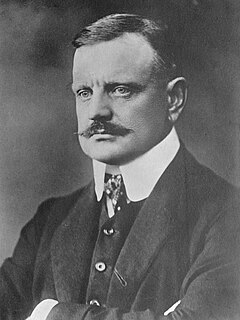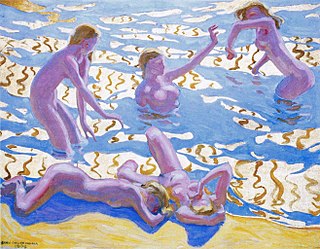Related Research Articles

In classical Greek mythology, Syrinx was a nymph and a follower of Artemis, known for her chastity. Pursued by the amorous god Pan, she ran to a river's edge and asked for assistance from the river nymphs. In answer, she was transformed into hollow water reeds that made a haunting sound when the god's frustrated breath blew across them. Pan cut the reeds to fashion the first set of pan pipes, which were thenceforth known as syrinx. The word syringe was derived from this word.

In Greek mythology, Echo was an Oread who resided on Mount Cithaeron. Zeus loved consorting with beautiful nymphs and often visited them on Earth. Eventually, Zeus's wife, Hera, became suspicious, and came from Mount Olympus in an attempt to catch Zeus with the nymphs. Echo, by trying to protect Zeus, endured Hera's wrath, and Hera made her only able to speak the last words spoken to her. So when Echo met Narcissus and fell in love with him, she was unable to tell him how she felt and was forced to watch him as he fell in love with himself.
Overture in music was originally the instrumental introduction to a ballet, opera, or oratorio in the 17th century. During the early Romantic era, composers such as Beethoven and Mendelssohn composed overtures which were independent, self-existing instrumental, programmatic works that presaged genres such as the symphonic poem. These were "at first undoubtedly intended to be played at the head of a programme".

Jean Sibelius was a Finnish composer and violinist of the late Romantic and early-modern periods. He is widely recognized as his country's greatest composer, and his music is often credited with having helped Finland develop a national identity during its struggle for independence from Russia.

Carl August Nielsen was a Danish composer, conductor and violinist, widely recognized as his country's most prominent composer.
A symphonic poem or tone poem is a piece of orchestral music, usually in a single continuous movement, which illustrates or evokes the content of a poem, short story, novel, painting, landscape, or other (non-musical) source. The German term Tondichtung appears to have been first used by the composer Carl Loewe in 1828. The Hungarian composer Franz Liszt first applied the term Symphonische Dichtung to his 13 works in this vein.
Programme music or program music is a type of instrumental art music that attempts to render an extra-musical narrative musically. The narrative itself might be offered to the audience through the piece's title, or in the form of program notes, inviting imaginative correlations with the music. A well-known example is Hector Berlioz's Symphonie fantastique, an instrumental work which relates a series of morbid fantasies concerning the unrequited love of a sensitive poet involving murder, execution, and the torments of Hell.

Daphnis et Chloé is a ballet in one act with three parts (scenes) by Maurice Ravel described as a "symphonie chorégraphique". The scenario was adapted by Michel Fokine from a romance by the Greek writer Longus thought to date from around the 2nd century AD. Scott Goddard published a contemporary commentary that discussed the changes to the story that Fokine made to prepare a workable ballet scenario. The story concerns the love between the goatherd Daphnis and the shepherdess Chloé.

Carl Ditters von Dittersdorf was an Austrian composer, violinist and silvologist. He was a friend of both Haydn and Mozart.
Syrinx, L. 129, is a piece of music for solo flute which Claude Debussy wrote in 1913. It generally takes three minutes or less to perform. It was the first significant piece for solo flute after the Sonata in A minor composed by C. P. E. Bach over 150 years before (1747), and it is the first such solo composition for the modern Böhm flute, developed in 1847.

Frederik Reesen Magle is a Danish composer, concert organist, and pianist. He writes contemporary classical music as well as fusion of classical music and other genres. His compositions include orchestral works, cantatas, chamber music, and solo works, including several compositions commissioned by the Danish Royal Family. Magle has gained a reputation as an organ virtuoso, and as a composer and performing artist who does not refrain from venturing into more experimental projects – often with improvisation – bordering jazz, electronica, and other non-classical genres.
Symphonic Metamorphosis of Themes by Carl Maria von Weber is an orchestral work written by German composer Paul Hindemith in America in 1943.

The Oceanides, Op. 73, is a single-movement tone poem for orchestra written in 1913–14 by the Finnish composer Jean Sibelius. The piece, which refers to the nymphs in Greek mythology who inhabited the Mediterranean Sea, premiered on 4 June 1914 at the Norfolk Music Festival in Connecticut with Sibelius conducting. Praised upon its premiere as "the finest evocation of the sea ... ever ... produced in music", the tone poem, in D major, consists of two subjects, said to represent the playful activity of the nymphs and the majesty of the ocean, respectively. Sibelius gradually develops this material over three informal stages: first, a placid ocean; second, a gathering storm; and third, a thunderous wave-crash climax. As the tempest subsides, a final chord sounds, symbolizing the mighty power and limitless expanse of the sea.
Six Metamorphoses after Ovid is a piece of program music for solo oboe written by English composer Benjamin Britten in 1951.

Saul og David is the first of the two operas by the Danish composer Carl Nielsen. The four-act libretto, by Einar Christiansen, tells the Biblical story of Saul's jealousy of the young David, taken from the Book of Samuel. The first performance was at the Royal Danish Theatre, Copenhagen, on 28 November 1902.

The symphonic poems of the Hungarian composer Franz Liszt are a series of 13 orchestral works, numbered S.95–107. The first 12 were composed between 1848 and 1858 ; the last, Von der Wiege bis zum Grabe, followed in 1882. These works helped establish the genre of orchestral program music—compositions written to illustrate an extra-musical plan derived from a play, poem, painting or work of nature. They inspired the symphonic poems of Bedřich Smetana, Antonín Dvořák, Richard Strauss and others.

Carl Nielsen's Helios Overture, Opus 17, is a concert overture which was first performed by the Royal Danish Orchestra, conducted by Johan Svendsen, on 8 October 1903 in the large hall of the Odd Fellows Mansion in Copenhagen.
Fynsk Foraar, for soloists, chorus and orchestra, Opus 42, is Carl Nielsen's last major choral work. Written to accompany a prizewinning text by Aage Berntsen, it was first performed in Odense's Kvæghal on 8 July 1922 where it was conducted by Georg Høeberg.
Metamorphoses is a Latin narrative poem by the Roman poet Ovid, considered his magnum opus. Comprising fifteen books and over 250 myths, the poem chronicles the history of the world from its creation to the deification of Julius Caesar within a loose mythico-historical framework. Although meeting the criteria for an epic, the poem defies simple genre classification by its use of varying themes and tones.

The Symphony No. 2, Op. 14, is a three-movement orchestral composition by the Swedish composer Dag Wirén, who wrote the piece from 1938–39. Despite its numbering, the Second Symphony represents Wirén's first contribution to the form as a professional. Swedish conductor Sixten Eckerberg premiered the new symphony with the Gothenburg Symphony Orchestra in Gothenburg on 13 October 1940. Although the public received the premiere positively, the critics cautioned that the new work was mildly derivative of Carl Nielsen. At 30 minutes, the Second is the longest of Wirén's four essays in the genre, as well as, stylistically, the most late-Romantic and pastoral of the set.
References
- 1 2 3 4 Peter Hauge, "Pan and Syrinx", Orchestral Works 2, Carl Nielsen Edition Archived 2010-04-09 at the Wayback Machine , Royal Danish Library. Retrieved 9 November 2010.
- ↑ Ovid, Metamorphoses 1.689ff
- ↑ Joseph Stevenson, "Review: Pan og Syrinx (Pan and Syrinx), for orchestra, FS 87 (Op. 49)", Answers.com. Retrieved 9 November 2010.